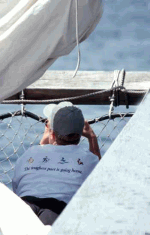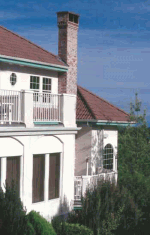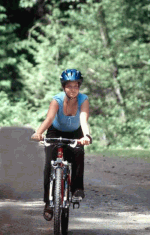written and photographed by Mary L. Peachin
Apr 2002, Vol. 6 No. 6
 The switchbacks of the trail, edged by Western sword fern, rose steeply through the second-growth forest of western red cedar and Douglas fir. After we’d hiked a mile or so, the treeline ended at the thousand-foot summit of Mt. Galiano. The 360-degree view—scattered islands beyond the lush shore—was stunning. Not far from the summit, we could see scattered remnants of a 25-year-old airplane crash.
The switchbacks of the trail, edged by Western sword fern, rose steeply through the second-growth forest of western red cedar and Douglas fir. After we’d hiked a mile or so, the treeline ended at the thousand-foot summit of Mt. Galiano. The 360-degree view—scattered islands beyond the lush shore—was stunning. Not far from the summit, we could see scattered remnants of a 25-year-old airplane crash.
Later that afternoon, I lounged in my room at the Woodstone Country Inn, watching black-tailed deer munch the pastoral fields outside my window, just beyond the fragrant gardens of purple California lilacs and golden poppies.
 It was just another spectacular day on an Austin-Lehman Adventures, a six-day hiking, bicycling, and kayaking trip to Galiano, Salt Spring, and Vancouver, the three Gulf Islands in British Columbia’s Georgia Strait.
It was just another spectacular day on an Austin-Lehman Adventures, a six-day hiking, bicycling, and kayaking trip to Galiano, Salt Spring, and Vancouver, the three Gulf Islands in British Columbia’s Georgia Strait.
On the first night of the trip guide Carl McLellan meet me at the Galiano dock where I had arrived by floatplane to catch up with the other five guests who had met in Victoria Airport. They had been shuttled by guide Marcy Lee McLellan on BC Ferry for the 45-minute ride to Galiano Island’s Woodstone. The group gathered to share dinner before an early bedtime.
Following breakfast the next morning, we load into Austin-Lehman’s van and motor along Galiano’s one road to the Bodega Ridge trailhead. The four-mile trail is part of the Pacific Marine Heritage Legacy, an initiative between Canada and British Columbia designed to protect the marine area. The trail follows an elevated ridge that rises gradually to about 900 feet. Red barkless madrone trees—said to shed their bark every three months—Douglas fir, and several species of bracken and swordfern dominate the forest. The bright yellow blossoms of the Scotch broom shrub, a non-native member of the pea family considered a weed by locals, brighten the trail. Ocean spray shrubs, members of the rose family, droop with creamy white flowers. (The shrub is considered by some an allergen; folklore suggests it is a cure for stomach ailments.)
 We continue along the ridge, keeping a careful eye out for stinging nettle, passing thimbleberry and salmonberry, not yet ready to be picked. Frilly white yarrow and poisonous yellow Death Camas flowers surround a grove of manzanita trees, “old man’s beard” moss hanging from their branches. The spring has coaxed into bloom the slender spire orchid, tiny Nootka roses, fool’s onion, and Harvest Brodiasa lilies.
We continue along the ridge, keeping a careful eye out for stinging nettle, passing thimbleberry and salmonberry, not yet ready to be picked. Frilly white yarrow and poisonous yellow Death Camas flowers surround a grove of manzanita trees, “old man’s beard” moss hanging from their branches. The spring has coaxed into bloom the slender spire orchid, tiny Nootka roses, fool’s onion, and Harvest Brodiasa lilies.
Galiano is known as “the Jewel of the Gulf of Georgia.” Long before it was found by Dionisio Galiano, who arrived from Spain in 1792, Salish First Nations people inhabited the island. The youngest member of our group, 14-year-old Lindsay Hallford, perches on a rock called Lover’s Leap, scanning the horizon for a bald eagle or peregrine falcon. In the distance we see the more populated island of Salt Spring. At the summit, we take a break before heading back. Marcy and Carl, who have retreated into the woods, return to pass a plate of fresh watermelon, cherries, and strawberries, a gourmet treat in the wilderness.
 Montegue Harbour’s tranquil waters are the setting for our first kayak trip, the next day’s adventure. We get a quick kayak lesson, then enter the harbor in our one- and two-person boats, skimming low enough to the bank to spot river otters, harbor seals, and cormorants feeding on needlefish. After three hours, we return to the dock and Marcy’s snack of fresh vegetables. Some of the group climb a huge oak tree said to be a meeting place, or potlatch, for the Salish First Nations people.
Montegue Harbour’s tranquil waters are the setting for our first kayak trip, the next day’s adventure. We get a quick kayak lesson, then enter the harbor in our one- and two-person boats, skimming low enough to the bank to spot river otters, harbor seals, and cormorants feeding on needlefish. After three hours, we return to the dock and Marcy’s snack of fresh vegetables. Some of the group climb a huge oak tree said to be a meeting place, or potlatch, for the Salish First Nations people.
The trip, while challenging, is far from bare-bones. Nice touches from our guides continue: one night there is a T-shirt on my bed, another a postcard, a packet of bath salts, a small carving of a hummingbird. The cup holder on the dash of the van is adorned with fresh flowers in a bicycle water bottle. A small red carpet is placed on the ground when we unload.
The trip includes all meals, with the exception of one dinner in Salt Spring. During group meals, Carl and Marcy usually whet our appetites by ordering a few appetizers. We then order whatever and as much as we want off the menu, paying only for alcoholic beverages.
 After two days in Galiano, we sail three hours to Salt Spring Island on Earthlight, a 52′ Polynesian catamaran. (Of course, we take our time, breaking for a picnic lunch in a secluded cove.) The island is named for the 14 saltwater springs found at its north end. The largest of the southern Gulf Islands, with 10,000 residents, Salt Spring has a small but successful economy supported by tourism and sheep raising.
After two days in Galiano, we sail three hours to Salt Spring Island on Earthlight, a 52′ Polynesian catamaran. (Of course, we take our time, breaking for a picnic lunch in a secluded cove.) The island is named for the 14 saltwater springs found at its north end. The largest of the southern Gulf Islands, with 10,000 residents, Salt Spring has a small but successful economy supported by tourism and sheep raising.
We settled in at the luxurious Relais and Chateaux Hastings House, where we’ll spend two nights. It’s recognized as the most luxurious inn in the Gulf Islands. Each of us has a suite with gas fireplace and balcony overlooking Ganges harbor. Formal tea with crumpets is served in late afternoon; properly dressed guests can join those who are dirty from hiking, biking, or kayaking. Dinner is a more formal five-course meal.
That afternoon, we see the van (which has arrived by BC Ferry) unloading a fleet of 27-speed Gary Fisher mountain bikes. Our next activity: a 13-mile bike ride up and down the challenging Salt Spring hills.
 Ruckle Provincial Park is part of a thousand-acre farm owned by Henry Ruckle, one of the first non-natives to immigrate to Salt Spring in 1877. A five-mile trail begins in second-growth forest of big leaf maple and Western hemlock, then meanders along the shoreline to Bear Point, an overlook where eagles soar over Swanson Channel. At the end of our hike, Marcy is again waiting on the waterfront at Beaver Point with a picnic lunch of pizza, salad, and angel food cake covered in fresh fruit and yogurt.
Ruckle Provincial Park is part of a thousand-acre farm owned by Henry Ruckle, one of the first non-natives to immigrate to Salt Spring in 1877. A five-mile trail begins in second-growth forest of big leaf maple and Western hemlock, then meanders along the shoreline to Bear Point, an overlook where eagles soar over Swanson Channel. At the end of our hike, Marcy is again waiting on the waterfront at Beaver Point with a picnic lunch of pizza, salad, and angel food cake covered in fresh fruit and yogurt.
Soon it’s kayaking time again. Bill Elford and Shannon Kendal of Sea Otter Kayaking give us a briefing and, once again, we’re paddling along windswept islands, catching glimpses of the harbor seals that pop their heads out of the water for a curious peek. After a four-mile paddle, we take a break on a small beach. Marcy serves up some fresh honeydew.
 Following breakfast the next morning, we shuttle off to catch the ferry back to Vancouver Island. Heading south, we stop for a hike in Goldstream Provincial Park. A three-mile trail takes us through old-growth forest of huge western red cedars. We take a peek inside an abandoned gold mine, then continue up the dry, rocky creek to watch the towering Niagara Falls. This time we enjoy another excellent picnic lunch, which includes Greek salad, pita with hummus and tabouli, and fresh fruit.
Following breakfast the next morning, we shuttle off to catch the ferry back to Vancouver Island. Heading south, we stop for a hike in Goldstream Provincial Park. A three-mile trail takes us through old-growth forest of huge western red cedars. We take a peek inside an abandoned gold mine, then continue up the dry, rocky creek to watch the towering Niagara Falls. This time we enjoy another excellent picnic lunch, which includes Greek salad, pita with hummus and tabouli, and fresh fruit.
Unloading our bikes from the roof rack, we bicycle around Shawnigan Lake to Cherry Point Vineyard, a winery where we unwind from the day’s activities with wine, cheese, and a toast of good cheer.
Our last night is spent high in the hills of Malahat, about 30 minutes north of Victoria. The 23 rooms of The Aerie have gorgeous views of the Finlayson Arm of the Georgia Strait. Provincial parks surrounded the hillsides; in the background are the snow-capped peaks of Washington State’s Olympic Peninsula. The resort appears to have won every award possible for its luxury and chef Christophe Letard’s fine cuisine .
We leave the next day, laden with pleasant memories and sore muscles. We got a great taste of hiking, cycling, and kayaking, yet still enjoyed fine inns and gourmet cuisine. Austin-Lehman Adventures puts on a great trip for those who believe adventure travel doesn’t necessarily mean denying oneself the finer things.
If you go:
Austin-Lehman Adventures P.O. Box 8105, Billings, Montana 59108 1-800-575-1540 [email protected] www.austinlehman.com
Woodstone Country Inn 250-539-2022 [email protected] www.gulfislands.com/woodstone
Hastings House 800-661-9255 [email protected] www.hastingshouse.com
The Aerie Resort P.O. Box 108
Malahat, British Columbia VOR SLO www.aerie.bc.ca [email protected]
Sea Otter Kayaking 1-877-537-5678 [email protected] www.saltspring.com/kayaking
Pacific Marine Heritage Legacy 1-888-812-7778
